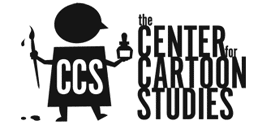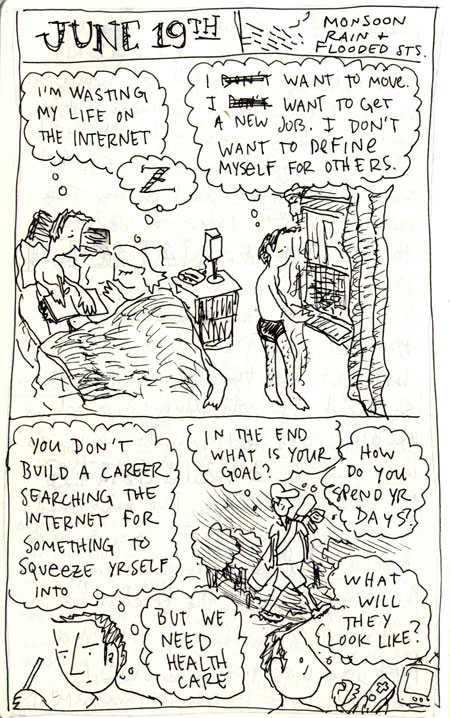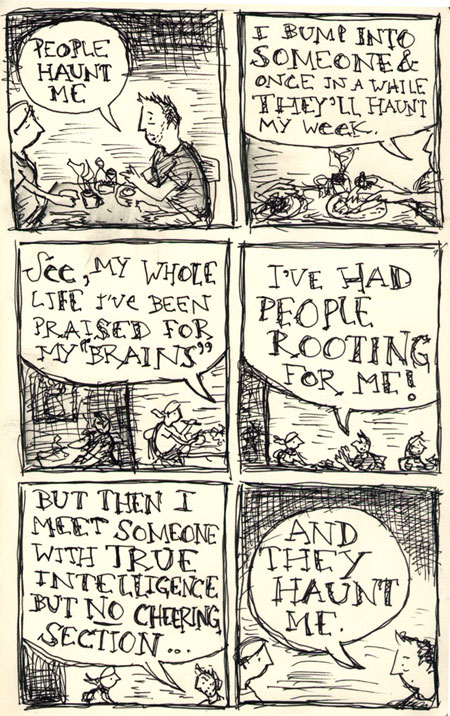The drawing skills don’t matter. It’s can you get down on paper what’s in your head? And if you can in such a way that when I read it you’re opening up a new eye to the world for me or a new ear to the how people talk, or what have you…then it’s cookin’. It’s comics. And that’s all that matters.”
– Steve Bissette, from the really great little trailer for Tara Wray’s documentary, “Cartoon College”
CENTER FOR CARTOON STUDIES GETS THE MFA STATUS (NOW THEY NEED SOME FUNDING)

Hooray! The State of Vermont Board of Education just approved The Center for Cartoon Studies for degree-granting authority. It will now be offering a two-year MFA.
“This is a landmark decision from the State,” says CCS board member and Chair of the Board of Trustees of the Vermont Arts Council, Peggy Kannenstine. “What NYU’s Film School is for film or Iowa’s Writing Workshop is for writing, The Center for Cartoon Studies is for comics. Beyond its educational impact, CCS is a fine example of the creative economy at work: helping revitalize a depressed downtown with the economic lift from students, faculty, and tourism. Its contributions to the State and Industry are impressive and quantifiable. It’s appropriate and important to recognize CCS’s quality and the high level of instruction with the terminal degree and certificates.”
James Sturm and the gang at CCS have been working on this for a while, and it’s really great news for the program, which, from everything I’ve read, seems like a really incredible place. (Read Patrick McDonnell’s speech to the 2007 graduating class, and check out Joe Lambert’s blog, and the I Know Joe Kimpel! blog for examples of student work. Also, a documentary called “Cartoon College” is coming out soon, chronicling a year in the life of CCS…)
The next step, of course, will be funding. There are all kinds of arguments about MFA programs, whether they’re good for writing or not, blah blah blah, but in the end, I believe that an MFA program is, or should be, nothing more than time to hone your craft, free from financial responsibilities. The best MFA programs in creative writing offer full tuition, a hefty stipend, and health insurance. (My buddy Brandon has a package like this at the University of Washington.) At this point, CCS is $15,000/year just for tuition.
I’m really not trying to de-value anyone who is paying for an MFA, or any kind of creative education, but the bottom line is, an MFA lets you teach at a university IF you get lucky enough to publish one or two successful books. With all the racket going on with student loans and student debt these days, I think it’s important for an artist plotting the path of his or her creative life be smart about finances. Going $30,000 into debt for an MFA from “cartoon college” is just not a move that I could justify for Meg and me.
I mean, why not just move to Chicago and stalk Chris Ware and the gang?
I’m kidding.
Tonight is a night were the money-grubbing pragmatist in me has clubbed the dreamy artist over the head. It probably has something to do with the job search.
Regardless, this is a step in the right direction, and I’m really happy for CCS and all involved. Now let’s wait and see if somebody drops a multi-million dollar endowment on them!
BECAUSE THIS BLOG HAS SEEMED TOO MUCH LIKE A BLOG RECENTLY…
…here is a sketchbook page I drew half-asleep at 1:30 last night:

Should I be posting pages like this in the middle of a job search? Should I be posting pages like this at all? Probably not. But why not? Shouldn’t we all be honest with each other?
Looking for work sucks. It sucks horribly. The worst part is figuring out how to fit what it is that you do into language that a hiring manager can dig.
And quite honestly, I’m sympathetic with hiring managers. I’m sympathetic with all participants in the hiring process. How do we communicate what we’re looking for? How can we get on the same page? Finding work sure is a pain in the ass, so I can imagine hiring good workers must be a real pain in the ass, too.
I did a re-tooling of my sidebar on this page to try to distill what it is that I do and do well into a few sentences. I want to make my living communicating with pictures and words. It’s that simple. Communicating with pictures and words. That’s my passion, that’s my skill.

“But we need health care” is the punchline to our lives.
SPEAKING OF JOBS
Calling All MySpace Addicts: The Ad Industry Needs You
Want to get ahead in advertising? Then learn how to navigate MySpace, and pick up a programming language or two.
Ad agencies are about to trade three-martini lunches, schmooze-fests and fast-talking account executives for programmers, custom software and anthropologists who can navigate MySpace.
At an American Association of Advertising Agencies conference in New York last week, Colleen DeCourcy, chief experience officer for JWT, spoke about how social networks can be exploited for advertising purposes.
…. “Digital anthropologists are going to be the next people you scramble to hire,” DeCourcy said.
Maybe I should add “digital anthropologist” to my résumé. Save yourself the trouble! Hire me!
AT BREAKFAST, THIS MORNING

It’s my opinion that every couple should go out to breakfast at least once a week, if they can afford it. (The breakfast special at the Inn on Coventry is $3.35 or something.)
- ← Newer posts
- 1
- …
- 543
- 544
- 545
- 546
- 547
- …
- 635
- Older posts→